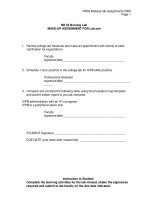Tài liệu Managing Your Business with Outlook 2003 for Dummies 17 doc
Bạn đang xem bản rút gọn của tài liệu. Xem và tải ngay bản đầy đủ của tài liệu tại đây (340.08 KB, 10 trang )
Web sites designed to trick them into divulging financial data such as credit-
card numbers, account usernames, passwords, and Social Security numbers.
Hijacking logos and brand names of banks, e-retailers, and credit-card
companies, phishers often trick recipients into responding. To find out
more about the subject, visit the Anti-Phishing Working Group site at
www.antiphishing.org.
To avoid phishing scams:
ߜ Be suspicious of any e-mail with urgent requests for personal financial
information.
ߜ Don’t believe e-mails directed at you from unexpected sources. Phishers
typically include upsetting or exciting (but false) statements in their
e-mails to get people to react immediately.
ߜ Never give personal data over e-mail, no matter who is asking for it.
Phishers typically ask for information such as usernames, passwords,
credit-card numbers, Social Security numbers, and so on.
ߜ Phisher e-mails are typically not personalized, while valid messages from
your bank or e-commerce company generally are.
ߜ Distinguish between personalized and addressed-to-you e-mails. Most
phisher e-mails have your name on them, but they’re not personally
written for you. In other words, they’re form letters.
ߜ Never fill out forms in e-mail messages that ask for personal financial
information.
ߜ You should communicate information such as credit-card numbers or
account information only via a secure Web site or by telephone.
ߜ Do not believe in any prize you may have won or miraculous offer to
release millions of dollars from a former African state secretary.
Tips authorized by the Anti-Phishing Working Group site at
www.antiphishing.org
141
Chapter 9: Managing E-Mail Cleanup
15_598155 ch09.qxp 12/28/05 8:41 PM Page 141
142
Part III: Handling Communication and Collaboration
15_598155 ch09.qxp 12/28/05 8:41 PM Page 142
Chapter 10
Facilitating Teamwork
In This Chapter
ᮣ
Working as a sports team
ᮣ
Creating intercompany teams
ᮣ
Collaborating by using Outlook Tools
A
ny business operates with teams, even if you work alone at your home
office. There is, at the very least, a kind of unofficial team made up of
your collaborators, suppliers, and customers. This chapter reveals how you
can use Outlook to keep your team working together and in perfect order.
Maintaining Team Commitment
The most important and fundamental team is that of a simple couple. Two
humans surviving together and growing a family — without this basic team
unit, you might not be here today. Growing from two people to a family or a
tribe, humans have always had to work together. Tribe leaders evolved to
help guide the group through dangers and to manage internal problems, such
as competition and jealousy. The most basic team commitment in our culture
is the wedding ceremony, and it starts with a question: Do you take this
person to be your spouse . . . for richer and for poorer, for better and for
worse, through sickness and in health . . . until death do you part?
This question illustrates a perfect example of the team commitment: To harbor
mutual respect and trust while maintaining a good climate anywhere and any
time. One of the ways of creating confidence and respect is by combining and
sharing resources. Sharing your goals, Tasks, and information resources with
your team makes your business stronger and better. Outlook’s sharing proper-
ties can help you share your goals, Tasks, and information with your teams —
whether your team is made up of family, business groups, or friends.
16_598155 ch10.qxp 12/28/05 8:36 PM Page 143
Maintaining a working team through good and bad times involves making the
commitment to the team. Keeping commitments requires that you negotiate
and maintain agreements. Daily actions based on mutual agreements, com-
pleted without excuses, is the key to making the team function properly.
Your job description (both within a particular project and in the company
in general) is an agreement.
Using Outlook’s collaborative tools to apply the following concepts, you can
keep your team working cooperatively and efficiently, as well as give your
business a boost of team power:
ߜ Leadership: The role of a leader is to plan, delegate, supervise, coach,
and keep the team moving in the right direction, scoring their goals.
Outlook’s sharing and supervision properties can enhance leadership
capabilities by helping team leaders zoom in on the players’ work (by
reading their Tasks and Calendars). For more on reading Tasks and
Calendars, see the upcoming section “Taking Advantage of Collaborative
Tools.”
ߜ Negotiation: Several steps are involved in achieving an agreement.
Negotiating is the art of having two or more sides arrive at a common
point or understanding. Outlook collaborative tools help you negotiate
requests, such as proposing a new meeting time, saying “No” to a Task
request and sending your reply with a new proposal, or coming up with
another way to solve the request. For more on this topic, read the
upcoming section “Taking Advantage of Outlook Collaborative Tools.”
ߜ Agreement management: Having an agreement is not a guarantee of get-
ting the job done. Supervision and coaching can help you avoid failures.
The Tasks list helps you manage each team member’s pending Tasks.
For more on Tasks, read the upcoming section “The agreement game,”
later in this chapter.
144
Part III: Handling Communication and Collaboration
Business, teamwork, and sports
I’ve never heard about a team — even a dream
team — winning a season without any training.
Even gifted athletes have to train and practice
together, or their individual strengths won’t
amount to much. Team sports, such as football,
soccer, basketball, and baseball, demand a per-
fect understanding and synchronicity among
players. Daily training helps improve the team’s
performance and helps create a unit that is
greater than the sum of its parts. The sports
analogy for business is so strong that sports
vocabulary is often used in a business context,
such as using
striking out
for losing an objective
or
coach
rather than mentor. Unfortunately, the
common goal shared by a business team is
often lost due to lack of instructions, lack of a
good coach, or lack of supervision. Coaching
and supervision in Outlook’s collaborative tools
help you score more home runs in less time.
16_598155 ch10.qxp 12/28/05 8:36 PM Page 144
ߜ Sharing: Companies that share values and information empower their
teams more effectively than those that don’t share information.
Outlook’s sharing properties empower each team member to get infor-
mation without interrupting the other players. For more on sharing, see
the upcoming section “The goal is sharing.”
ߜ Delegation: You are a doer, not a lazy person, and you wish you were an
Octopus so that you could work on more jobs at the same time. So, how
do you get more brains and arms working for you? Delegating to your
coworkers is the answer. Outlook’s delegation tools let your chosen
team members negotiate agreements on your behalf (accepting and
rejecting invitations), without your having to open your Inbox. Take a
breath and plan what you want to delegate. For more on delegation,
see the upcoming section “Delegating.”
ߜ Commitment: The real commitment is not only a matter of saying yes but
also having a willingness to do it. The Outlook Accept or Decline buttons
increase the commitment among parts. Few people will click an Accept
button without reading and thinking, “Am I willing to do this?” This
mental question increases the commitment. For more details, read the
upcoming section “The agreement game (Tasks),” later in this chapter.
Using E-Mail Tips to Promote
the Calendar
You can use Tasks and Invitation requests to organize your team’s agree-
ments and keep it working together and in unison. Outlook’s supervision and
delegation features help move the ball downcourt toward the goal.
One such method is to send an e-mail tip. However, you need to ask yourself
the following questions before sending a tip:
ߜ What is the advantage to your team if the members start using this tip?
ߜ Does your team know about the Calendar?
ߜ Does your team know how to use the Calendar?
ߜ Why is your team not using the Calendar?
The advantage of using the Calendar for invitations is saving time. Your team
may not be using the product because they don’t know about its benefits.
For example, some managers told the HR department that their teams hadn’t
been answering Calendar invitations by using the Accept or Decline buttons
in Outlook, thus forcing the team to waste time by using the phone to confirm
145
Chapter 10: Facilitating Teamwork
16_598155 ch10.qxp 12/28/05 8:36 PM Page 145









